Scottish Shelf Model. Part 5: Wider Loch Linnhe System Sub-Domain
Part 5 of the hydrodynamic model developed for Scottish waters.
Appendix A : Technical Note: Local wind conditions derivation
TECHNICAL NOTE
WLLS Wind Analysis
| PREPARED FOR: |
Marine Scotland |
|---|---|
| COPY TO: |
|
| PREPARED BY: |
Ilektra-Georgia Apostolidou and Caroline Stuiver |
| DATE: |
04-Sep-2015 |
| PROJECT NUMBER: |
462000 |
1. Part 1: Loch Linnhe
2. Introduction
One of the aims of the WLLS study was to include spatially and temporally variable wind in Loch Linnhe. The proposed approach was to obtain wind speed/direction from a number of sites in and around WLLS. The wind speeds and directions at the different sites are correlated against a reference site away from the complex topography. The result of this analysis is then used to determine the spatial variation of wind data within Loch Linnhe.
This note describes the procedure followed for the Wider Loch Linnhe System ( WLLS) Wind Analysis and presents the main outcomes.
3. Data Overview
Data for 2011-2012 were available from the following sources:
- MARLAB Data: Duart, Fort William, Cuil Bay and Kingair Loch
- SAMS Data: Oban (Dunstaffnage data were available only until 2010 so were not considered)
A location map is shown in Figure 1. Duart and Oban are the two possible reference stations towards the mouth of Loch Linnhe. The rest (inside Loch Linnhe) are used for the correlation.
The common data periods for 2011-2012 were:
- Dataset 1: July-December 2011
- Dataset 2: April-October 2012
Adjustments to the wind speed data were carried out to correct the wind data at all stations to 2-hour averaged wind speeds and a common elevation of 10m above MSL. The adjustments are described below.
Figure 1 WLLS Stations Location Map
'Contains Ordnance Survey data © Crown copyright and database right 2013'.
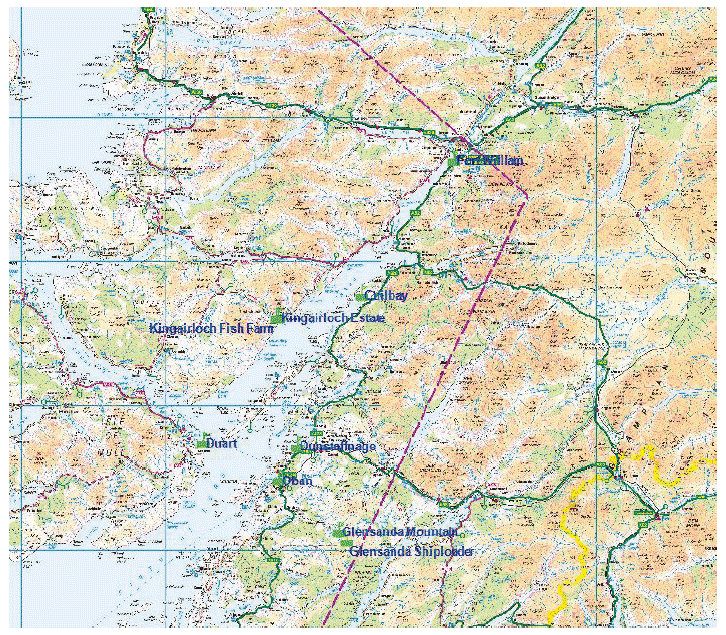
4. Wind speed adjustments
- For each station the following corrections were applied:
- 2-hours averaged values (wind speeds and directions) were calculated for Oban (as the data were in 10min intervals) and in order to match the MARLAB stations and facilitate the correlation (conversion with a factor of 0.92 was applied as calculated per Figure II-2-1 in Coastal Engineering Manual - Part II - Chapter 2).
- Wind speeds adjustment for altitude to common height of 10m above sea level, by applying the "1/7" rule (see again CEM - Part II - Chapter 2). This approximation is given as

- where z is measured in meters. The elevation of each station is detailed in Table 1.
- Land-based wind speeds were not adjusted for over sea wind speeds, as all the locations are near the shore.
Table 1
WLLS Weather Stations
Elevation and data Averaged
Time
| Station |
Elevation (mASL) |
Data averaged time (h) |
Period Data Available |
Source of Data |
|---|---|---|---|---|
| CuilBay |
4 |
2 |
19/04/2011-06/12/2011 and 26/03/201-23/10/2012 |
MARLAB |
| Fort William |
8 |
2 |
25/07/2011-05/12/2011 and 01/01/2012-25/10/2012 |
MARLAB |
| KingairLoch |
24 |
2 |
19/04/2011-02/12/2011 and 07/06/2012-29/08/2012 |
MARLAB |
| Duart |
40 |
2 |
27/04/2011-06/12/2011 and 27/03/2012-24/10/2012 |
MARLAB |
| Oban |
13 |
0.17 |
01/01/2011-30/12/2011 and 01/01/2012-28/11/2012 |
SAMS |
The adjusted data are plotted in Figures 2 and 3 for the respective data periods. The Fort William values from April till August 2012 were considerably higher (probably equipment fault) and were excluded from the analysis.
Figure 2 WLLS Wind Speed Data 2011
Data period: July to December 2011.

Figure 3 WLLS Wind Speed Data 2012
Data period: April to October 2012.

5. Wind roses
Wind roses for each of the sites were plotted, making sure they cover same period so that comparison is fair. The wind roses for Datasets 1 and 2 are shown in Figures 4 and 5 respectively. In Dataset 1 South-West winds were predominant, probably due to the Loch Linnhe orientation. In Dataset 2 for almost all the stations mostly North-East and South-West wind directions can be observed except for Oban (East winds).
Figure 4 WLLS Wind Roses 2011
Data period: July to December 2011.
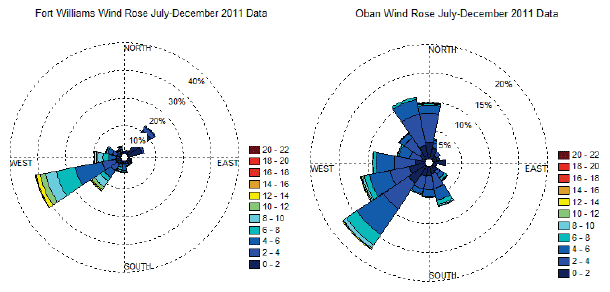
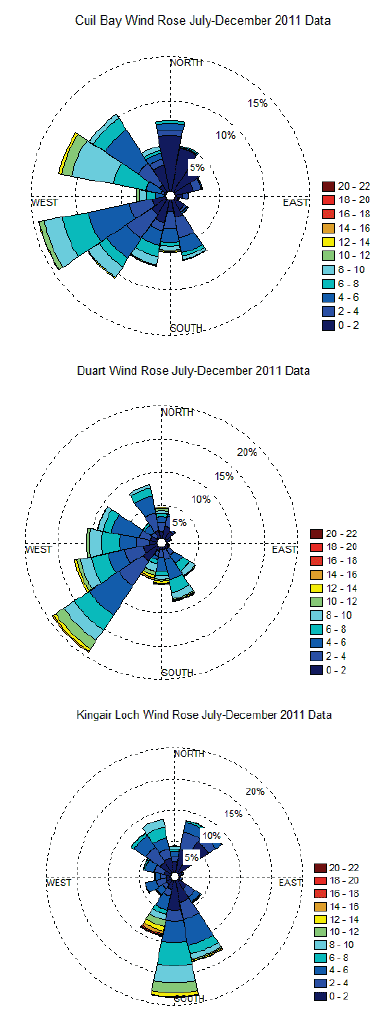
Figure 5 WLLS Wind Roses 2012
Data period: April to October 2012 (Kingair Loch data only from July to August 2012)
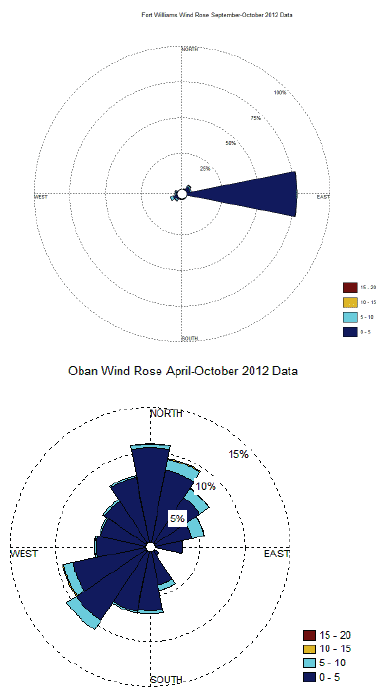
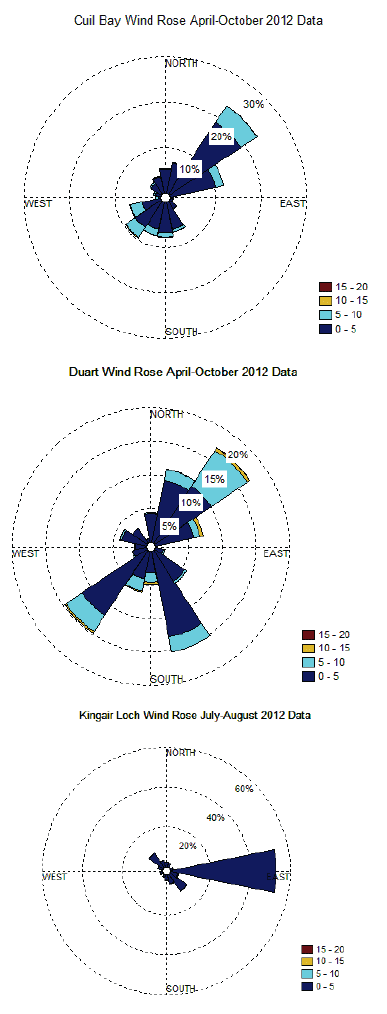
6. Methodology
The methodology used for the wind analysis is outlined as follows:
- For each station inside the loch, wind speed ratio (wind speed at station / wind speed at reference station) and wind direction difference (wind direction at station - wind direction at reference station) are calculated for each of the 16 direction sectors. The reference station is selected as a station in a relatively exposed location outside the loch.
- A distance weighted algorithm is used to determine the map of wind speed and directions in the loch based on wind conditions at the reference station and the calculated wind speed ratio and wind direction differences.
The methodology is presented in more detail in the sub-sections below.
- The correlation for wind speed is done for a number of directional sectors. Because the original MARLAB data were given in cardinal directions they were converted in degrees according to Table 2 and Figure 6, resulting to 16 directional sectors. This obviously has a limitation for the directional correlation.
Table 2 Reference table for wind direction conversion from cardinal to decimal
| Wind Direction and Degrees | ||
|---|---|---|
| Cardinal Direction | Direction sector (degrees) | Average wind direction (degrees) |
| N | 348.75 - 11.25 | 0 |
| NNE | 11.25 - 33.75 | 22.5 |
| NE | 33.75 - 56.25 | 45 |
| ENE | 56.25 - 78.75 | 67.5 |
| E | 78.75 - 101.25 | 90 |
| ESE | 101.25 - 123.75 | 112.5 |
| SE | 123.75 - 146.25 | 135 |
| SSE | 146.25 - 168.75 | 157.5 |
| S | 168.75 - 191.25 | 180 |
| SSW | 191.25 - 213.75 | 202.5 |
| SW | 213.75 - 236.25 | 225 |
| WSW | 236.25 - 258.75 | 247.5 |
| W | 258.75 - 281.25 | 270 |
| WNW | 281.25 - 303.75 | 292.5 |
| NW | 303.75 - 326.25 | 315 |
| NNW | 326.25 - 348.75 | 337.5 |
Figure 6 Cardinal System for Wind Direction Index
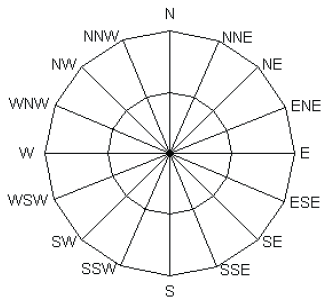
- The correlation analysis resulted to 18 spreadsheets - look up tables: 2 possible reference stations outside Loch Linnhe (Duart and Oban) and 3 station inside Loch Linnhe (Fort William, Cuil Bay and Kingair Loch) for 3 datasets (Dataset 1, Dataset 2 and combined Datasets 1 and 2).
- For each station inside Loch Linnhe the following were calculated:
- Average wind speed ratio (wind speed at station / wind speed at reference station) for each of the 16 direction sectors.
- Average wind direction difference (wind direction at station - wind direction at reference station) for each of the 16 direction sectors.
- For each station, the following plots were produced:
- Average wind speed ratio versus wind direction at reference station (1 plot for each correlation pair).
- Average wind direction difference versus wind direction at reference station (1 plot for each correlation pair).
- The correlation plots with Duart as reference point for Datasets 1 and 2 combined are included in Appendix A and the XY plots (wind speed at Loch Linnhe stations against wind speed at Duart) are included in Appendix B.
- For each station and data period, a look up table was produced. The look-up tables derived using Dataset 1 are shown in Tables 3 and 4 for Duart and Oban (as reference stations) respectively.
Table 3 Look up table with Duart as reference station (Dataset 1)
| Reference Station | Duart | ||||||||||||||||
|---|---|---|---|---|---|---|---|---|---|---|---|---|---|---|---|---|---|
| Loch Linnhe Station | Cuil Bay | ||||||||||||||||
| Look up Table | |||||||||||||||||
| From Direction (dgr) | 0.0 | 11.3 | 33.8 | 56.3 | 78.8 | 101.3 | 123.8 | 146.3 | 168.8 | 191.3 | 213.8 | 236.3 | 258.8 | 281.3 | 303.8 | 326.3 | 348.8 |
| To Direction (dgr) | 11.3 | 33.8 | 56.3 | 78.8 | 101.3 | 123.8 | 146.3 | 168.8 | 191.3 | 213.8 | 236.3 | 258.8 | 281.3 | 303.8 | 326.3 | 348.8 | 360.0 |
| Wind Speed ratio | 1.2 | 1.0 | 1.0 | 0.8 | 0.9 | 0.9 | 1.2 | 1.1 | 1.3 | 1.3 | 1.2 | 1.2 | 1.0 | 0.7 | 0.7 | 0.8 | 1.2 |
| Wind Direction Difference | 3.5 | 3.9 | -4.6 | -12.7 | 17.7 | -1.1 | 21.5 | 12.2 | -16.6 | -33.0 | -33.8 | -27.3 | -11.4 | 26.6 | 20.3 | 16.1 | 3.5 |
| Loch Linnhe Station | Fort William | ||||||||||||||||
| Look up Table | |||||||||||||||||
| From Direction (dgr) | 0.0 | 11.3 | 33.8 | 56.3 | 78.8 | 101.3 | 123.8 | 146.3 | 168.8 | 191.3 | 213.8 | 236.3 | 258.8 | 281.3 | 303.8 | 326.3 | 348.8 |
| To Direction (dgr) | 11.3 | 33.8 | 56.3 | 78.8 | 101.3 | 123.8 | 146.3 | 168.8 | 191.3 | 213.8 | 236.3 | 258.8 | 281.3 | 303.8 | 326.3 | 348.8 | 360.0 |
| Wind Speed ratio | 1.4 | 0.9 | 0.7 | 0.7 | 0.6 | 0.9 | 1.0 | 1.0 | 1.3 | 1.6 | 1.6 | 1.6 | 1.3 | 0.9 | 0.9 | 1.2 | 1.4 |
| Wind Direction Difference | -48.8 | -10.1 | -2.4 | -10.2 | -28.7 | -21.0 | -16.2 | 0.9 | 1.2 | -16.6 | -32.7 | -32.6 | -42.0 | -15.6 | -4.5 | -42.9 | -48.8 |
| Loch Linnhe Station | Kingair Loch | ||||||||||||||||
| Look up Table | |||||||||||||||||
| From Direction (dgr) | 0.0 | 11.3 | 33.8 | 56.3 | 78.8 | 101.3 | 123.8 | 146.3 | 168.8 | 191.3 | 213.8 | 236.3 | 258.8 | 281.3 | 303.8 | 326.3 | 348.8 |
| To Direction (dgr) | 11.3 | 33.8 | 56.3 | 78.8 | 101.3 | 123.8 | 146.3 | 168.8 | 191.3 | 213.8 | 236.3 | 258.8 | 281.3 | 303.8 | 326.3 | 348.8 | 360.0 |
| Wind Speed ratio | 1.8 | 0.5 | 0.6 | 0.8 | 0.9 | 1.1 | 1.3 | 0.7 | 0.5 | 0.6 | 0.9 | 1.3 | 1.1 | 1.0 | 0.9 | 1.3 | 1.8 |
| Wind Direction Difference | 19.4 | -1.2 | -21.7 | -6.3 | 4.9 | -5.1 | -15.6 | -40.2 | -49.9 | -18.0 | 5.0 | 15.7 | 20.8 | -2.8 | -14.8 | 4.4 | 19.4 |
Table 4 Look up table with Oban as reference station (Dataset 1)
| Reference Station | Oban | ||||||||||||||||
|---|---|---|---|---|---|---|---|---|---|---|---|---|---|---|---|---|---|
| Loch Linnhe Station | Cuil Bay | ||||||||||||||||
| Look up Table | |||||||||||||||||
| From Direction (dgr) | 0.0 | 11.3 | 33.8 | 56.3 | 78.8 | 101.3 | 123.8 | 146.3 | 168.8 | 191.3 | 213.8 | 236.3 | 258.8 | 281.3 | 303.8 | 326.3 | 348.8 |
| To Direction (dgr) | 11.3 | 33.8 | 56.3 | 78.8 | 101.3 | 123.8 | 146.3 | 168.8 | 191.3 | 213.8 | 236.3 | 258.8 | 281.3 | 303.8 | 326.3 | 348.8 | 360.0 |
| Wind Speed ratio | 1.3 | 1.3 | 1.5 | 1.1 | 1.1 | 1.4 | 1.7 | 2.0 | 2.1 | 1.6 | 1.5 | 1.7 | 1.4 | 0.9 | 0.8 | 1.3 | 1.3 |
| Wind Direction Difference | 54.0 | 19.8 | -4.3 | -21.2 | -19.5 | -4.9 | 10.6 | -18.8 | -18.8 | -17.2 | -0.1 | 24.3 | 21.3 | 19.8 | 13.7 | 21.9 | 54.0 |
| Loch Linnhe Station | Fort William | ||||||||||||||||
| Look up Table | |||||||||||||||||
| From Direction (dgr) | 0.0 | 11.3 | 33.8 | 56.3 | 78.8 | 101.3 | 123.8 | 146.3 | 168.8 | 191.3 | 213.8 | 236.3 | 258.8 | 281.3 | 303.8 | 326.3 | 348.8 |
| To Direction (dgr) | 11.3 | 33.8 | 56.3 | 78.8 | 101.3 | 123.8 | 146.3 | 168.8 | 191.3 | 213.8 | 236.3 | 258.8 | 281.3 | 303.8 | 326.3 | 348.8 | 360.0 |
| Wind Speed ratio | 2.9 | 2.5 | 2.6 | 1.9 | 1.6 | 1.6 | 1.9 | 2.3 | 2.5 | 2.3 | 2.5 | 3.1 | 2.5 | 1.8 | 1.0 | 0.8 | 2.9 |
| Wind Direction Difference | 21.6 | 5.7 | -8.6 | 2.0 | 2.0 | 17.5 | 27.0 | 28.5 | 16.7 | 13.5 | 17.2 | 20.8 | 14.2 | 24.7 | 3.4 | -28.8 | 21.6 |
| Loch Linnhe Station | Kingair Loch | ||||||||||||||||
| Look up Table | |||||||||||||||||
| From Direction (dgr) | 0.0 | 11.3 | 33.8 | 56.3 | 78.8 | 101.3 | 123.8 | 146.3 | 168.8 | 191.3 | 213.8 | 236.3 | 258.8 | 281.3 | 303.8 | 326.3 | 348.8 |
| To Direction (dgr) | 11.3 | 33.8 | 56.3 | 78.8 | 101.3 | 123.8 | 146.3 | 168.8 | 191.3 | 213.8 | 236.3 | 258.8 | 281.3 | 303.8 | 326.3 | 348.8 | 360.0 |
| Wind Speed ratio | 0.7 | 0.8 | 0.8 | 0.7 | 1.0 | 1.1 | 0.8 | 0.8 | 0.9 | 0.9 | 1.3 | 1.8 | 1.7 | 1.3 | 1.3 | 2.2 | 0.7 |
| Wind Direction Difference | -19.8 | -22.5 | -35.2 | -41.5 | -18.9 | -21.5 | -23.4 | -7.3 | -2.9 | 10.3 | 21.8 | 17.1 | -8.0 | -23.1 | -0.9 | 18.1 | -19.8 |
- For validation, the look up tables derived using Dataset 1 and both Oban and Duart as reference stations were used to predict Dataset 2 and the results were compared to the observed values. The comparison plots are shown in Figures 8, 9 and 10. The RMS Error and the Bias were calculated as listed in Table 5.
- The results show that the errors with Duart as reference station is lower. Thus, Duart is used as reference station for the prediction of the wind speed and directions inside Loch Linnhe. For this purpose the combined Datasets 1 and 2 were used to calculate the wind speed ratios and wind direction differences.
Table 5 RMS Error and Bias for the predicted Dataset 2 values (wind speed and wind direction)
| Wind Speed | Wind Direction | |||
|---|---|---|---|---|
| RMS Error | Reference Station | Reference Station | ||
| Loch Linnhe Station | Duart | Oban | Duart | Oban |
| Cuil Bay | 2 | 3 | 69 | 78 |
| Fort William | 2 | 5 | 59 | 88 |
| KingairLoch | 1 | 2 | 135 | 143 |
| Bias | Reference Station | Reference Station | ||
| Loch Linnhe Station | Duart | Oban | Duart | Oban |
| Cuil Bay | -1 | 0 | -3 | 0 |
| Fort William | -1 | 0 | 3 | 23 |
| KingairLoch | 0 | 1 | 1 | -2 |
Figure 8 Comparison between predicted and recorded Dataset 2 values for Cuil Bay
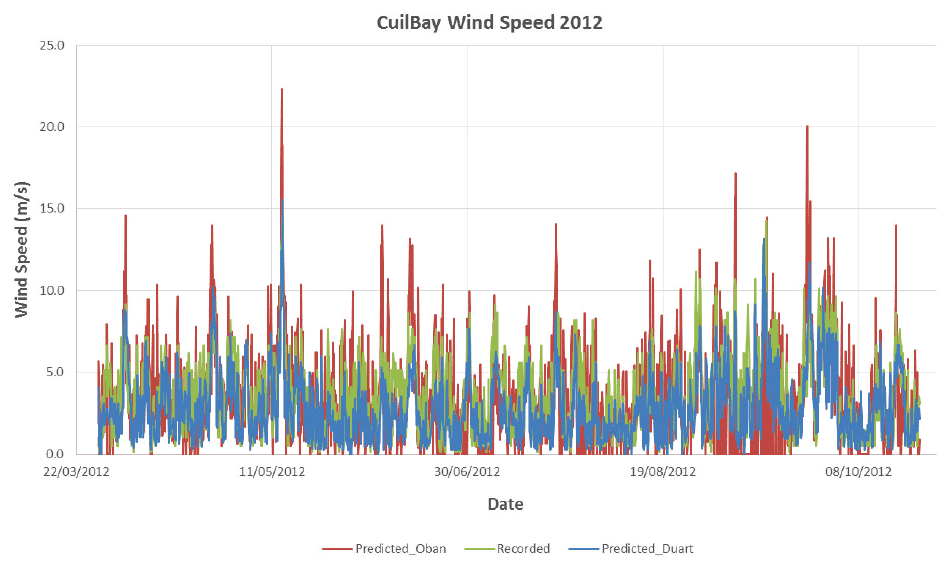
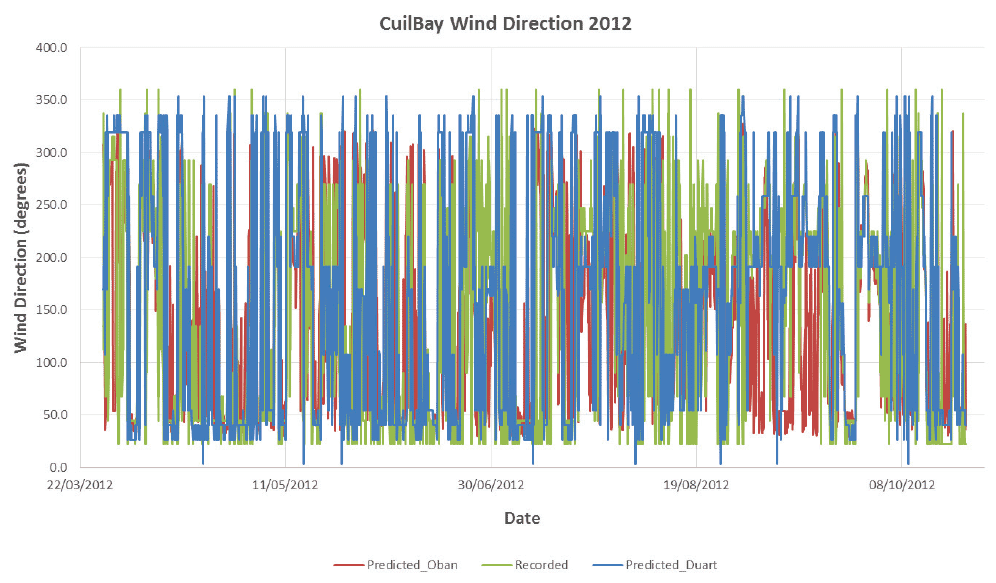
Figure 9 Comparison between predicted and recorded Dataset 2 values for Fort William
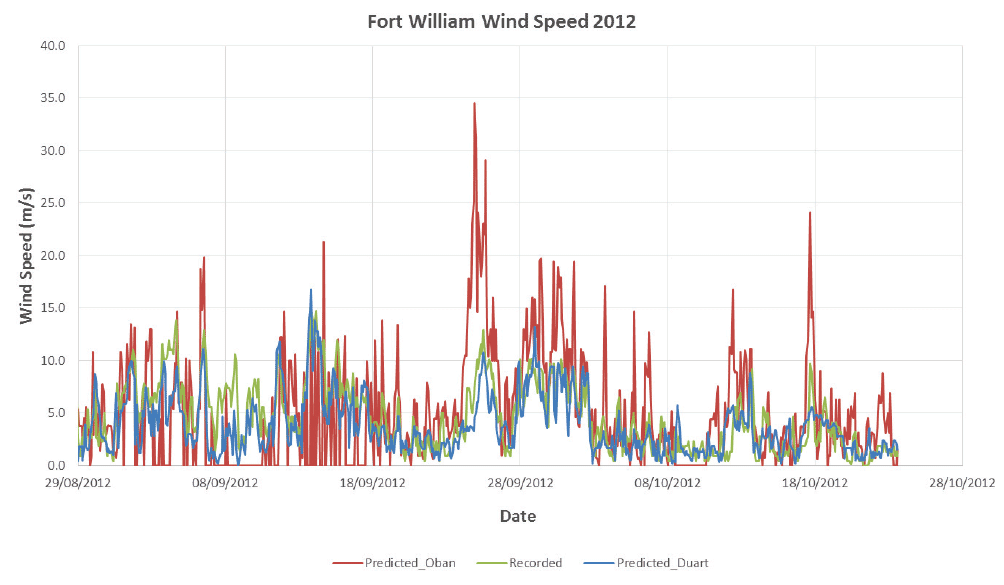
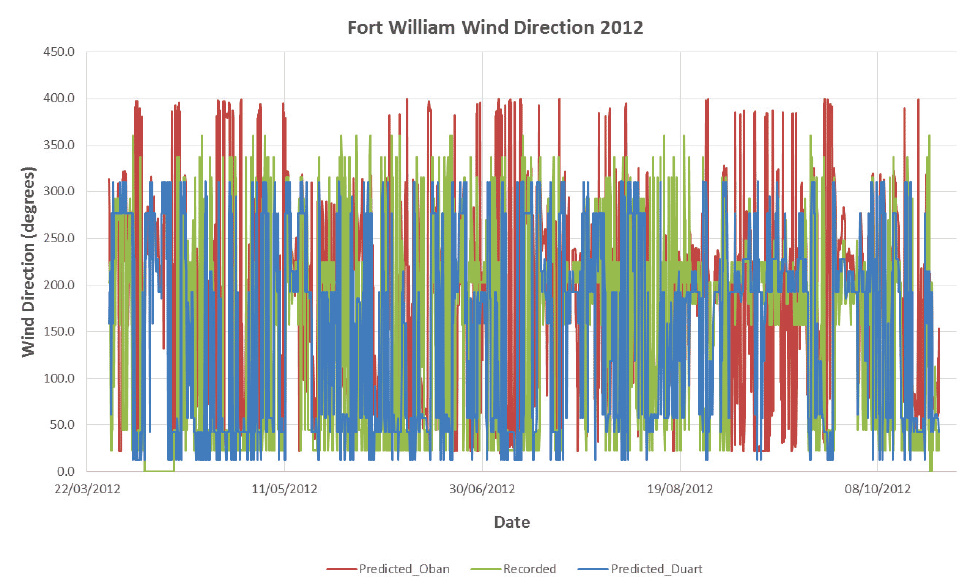
Figure 10 Comparison between predicted and recorded Dataset 2 values for Kingair Loch
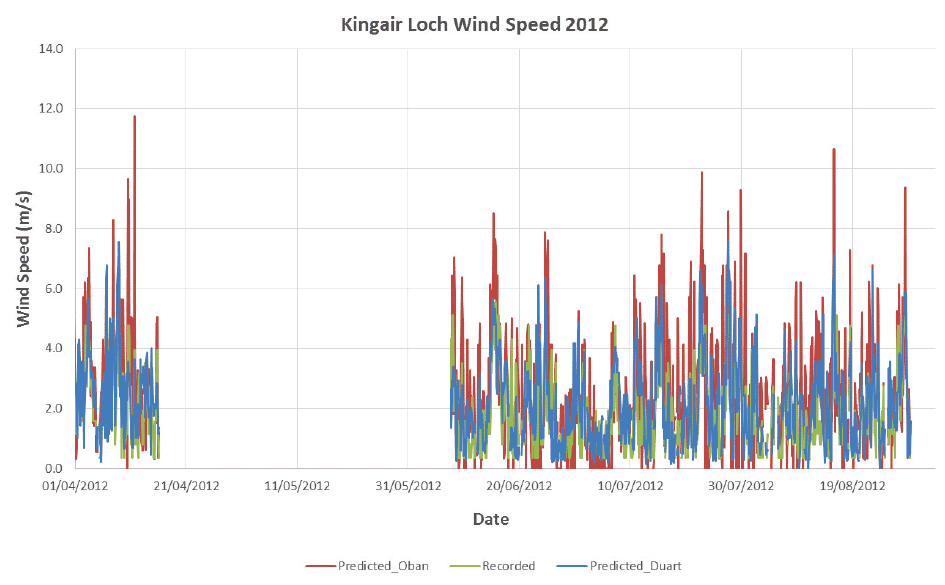
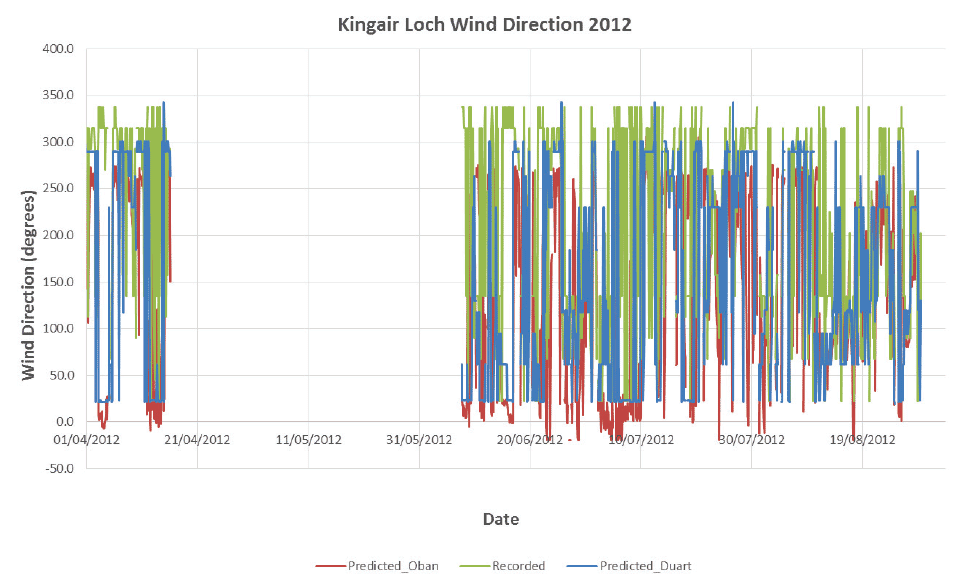
7. Modified map of wind data over Loch Linnhe
8. Comparison of observed and UK met office wind data at Duart
For carrying out the model simulations, the primary data available is the meteorological data file provided by the UK Met Office. This data is modified over Loch Linnhe using the directionally dependent wind speed ratios and wind direction differences derived from stations in Loch Linnhe.
First, the wind speed and direction data extracted from the meteorological file at Duart are compared with the MARLAB data for the same station, as shown in Figures 11 and 12 below. These figures show that the wind data extracted from the Met Office is broadly consistent with the measured wind data at Duart.
Figure 11 Comparison between Duart wind speed - Met file vs MARLAB
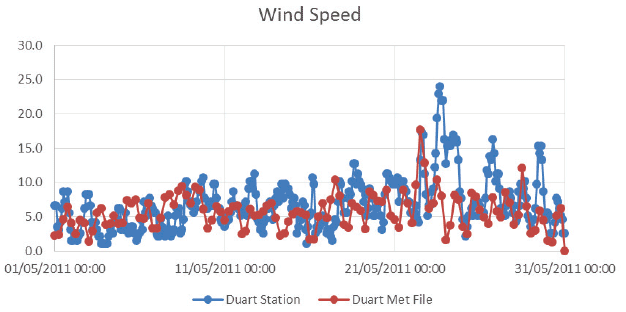
Figure 12 Comparison between Duart wind direction - Met file vs MARLAB
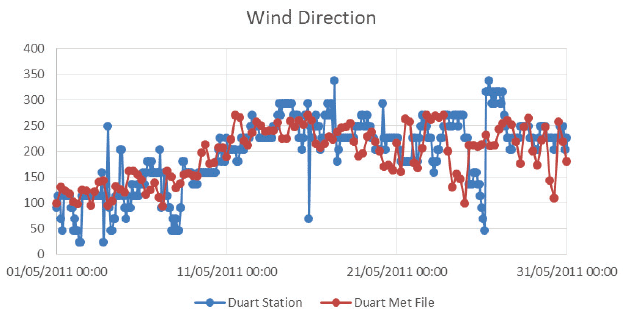
9. Spatial variation of observed wind data in Loch Linnhe
The spatial variation of wind speed ratios in Loch Linnhe is illustrated in Figures 13 and 14 using the directional wind speed ratios at Fort William and Cuil bay. In both figures, the blue lines represent the calculated wind speed ratios, while the red lines represent the schematised variation. The key results are summarised in Table 6. This shows that for wind directions from 270 to 135 oN (clockwise), the wind speed generally increases from Fort William through Cuil bay to Duart. On the other hand, for wind directions from 135 to 270 oN, the wind speed increases from Duart through Cuil bay to Fort William.
The calculated wind speed ratios for Kingair loch station is shown in Appendix A. This location exhibits double peaks (peaks of about 1.2 for wind direction of 135 and 255 oN) in the variation of wind speed ratios with directions at Duart. In particular, for wind directions from 135 to 255 oN, the wind speed is lower at Kingair loch, in contrast to observations at Cuil Bay or Fort William. It is considered that this behaviour is due to localised topography at this station, hence this station was excluded from further analysis.
Table 6 Variation in observed wind data at stations within Loch Linnhe
| Direction Sector |
Fort William |
Cuil Bay |
|---|---|---|
| 0 - 135 oN |
Wind speed at Fort William is lower than at Duart. Minimum ratio of 0.65 for wind from 70 +/- 20 oN. |
Wind speed at Cuil Bay is lower than at Duart. Minimum ratio of 0.80 for wind from 70 oN. |
| 135 - 270 oN |
Wind speed at Fort William is higher than at Duart. Maximum ratio of 1.55 for wind from 200 - 250 oN. |
Wind speed at Cuil Bay is higher than at Duart. Maximum ratio of 1.25 for wind from 150 - 250 oN. |
| 270 - 360 oN |
Wind speed at Fort William is about 90% of wind speed at Duart. |
Wind speed at Cuil Bay increases from 0.7 (270 oN) to 1.0 (360 oN) of the speed at Duart. |
Figure 15 shows in green the sector where the wind speed in Loch Linnhe is greater than wind speed at Duart and in red the sector where the wind speed in Loch Linnhe is lower than wind speed at Duart. For wind directions from 270 o N to 135 oN (clockwise), the wind speeds over Loch Linnhe are lower than wind speed at Duart. This is due to Duart being relatively exposed, while Cuil Bay and Fort William are sheltered from these directions (due to the hills). For wind direction from about NW (wind blowing offshore along the alignment of Loch Linnhe), wind speed is expected to increase from Fort William to Cuil Bay and to Duart. This is reproduced in the data. For wind direction from SW (wind blowing onshore along Long Linnhe), wind speed accelerates within Loch Linnhe, and increases towards Fort William.
Figure 13 Simplification of Spatial Wind Speed Variation - Fort William
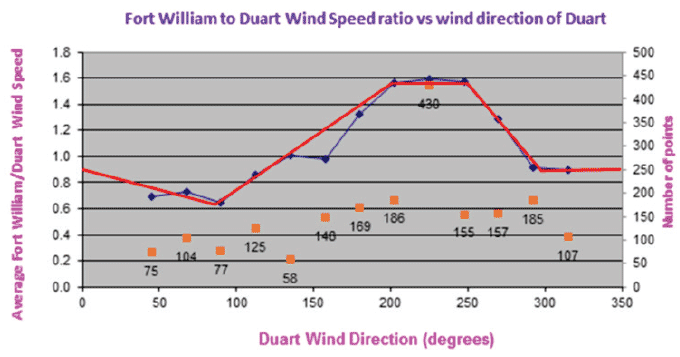
Figure 14 Simplification of Spatial Wind Speed Variation - Cuil Bay
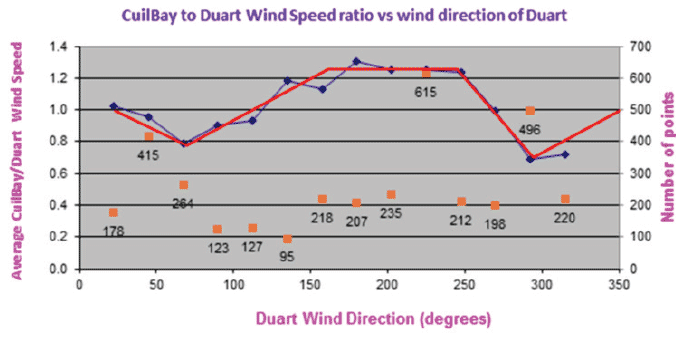
Figure 15 Comparison of wind speed inside Loch Linnhe and the speed at Duart for different directional sectors.
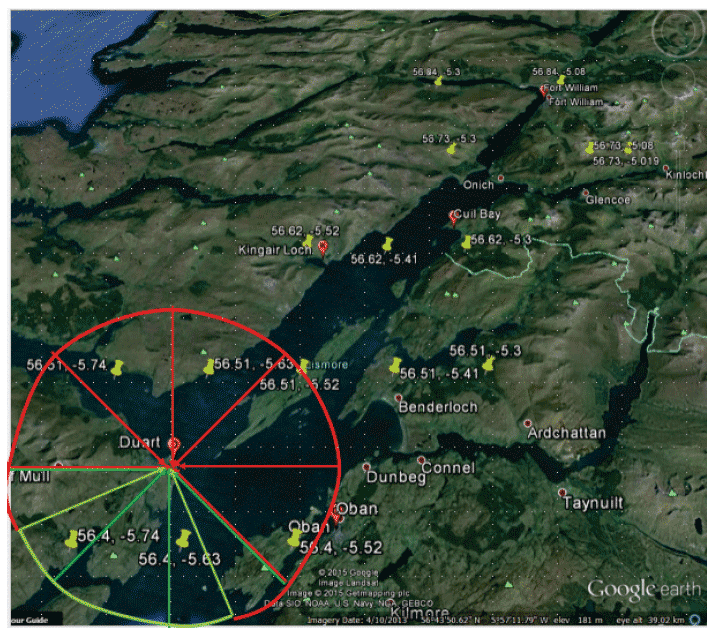
10. Interpolation of wind data over Loch Linnhe in the met data file
The wind speed and direction values inside Loch Linnhe were linearly interpolated using the distance of each point from the baseline through Duart (reference station), and the wind speed ratios (and direction differences) at Cuil bay and Fort William
Examples of the wind values in the met file before and after the interpolation are shown in Figures 16 and 17.
Figure 16 Wind Speed in the met file before (above) and after (below) the interpolation (values for 18 th of May 2011).
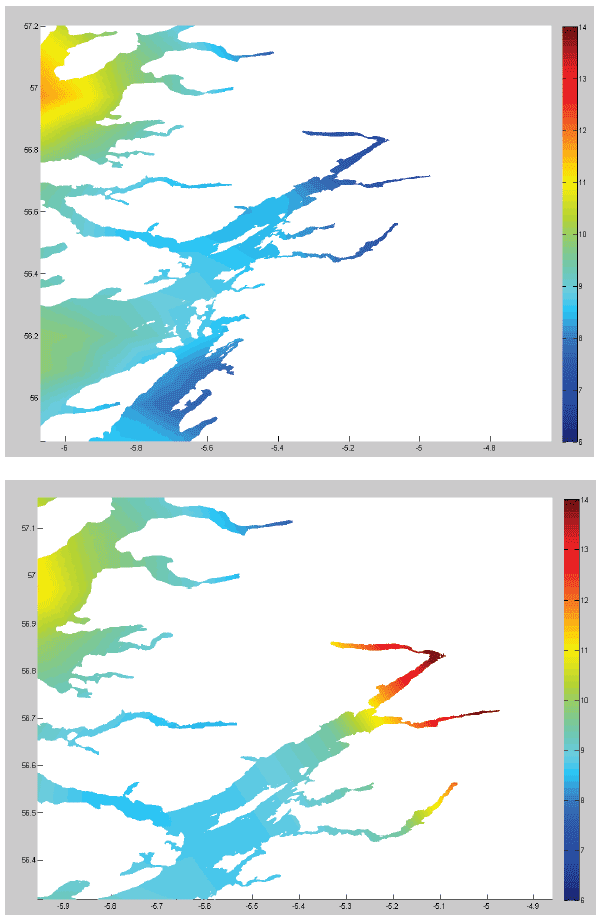
Figure 17 Wind Speed in the met file before (above) and after (below) the interpolation (values for 27 th of May 2011).
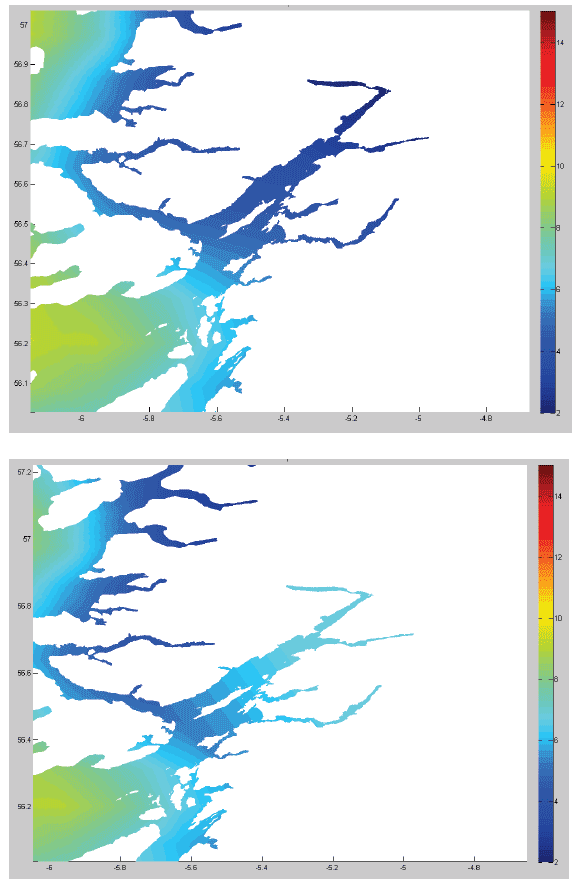
Conclusions and Recommendations
From the wind analysis for WLLS the following conclusions can be drawn:
- The wind station at Duart was found to give lower prediction error than Oban station when used as the reference station for determining wind speed ratios and wind direction differences inside Loch Linnhe.
- Analysis of the observed wind data at a number of stations in Loch Linnhe, show that for wind directions from the SSE to WSW, the wind speed increases with distance from Duart towards Fort William ( i.e. towards the upper sections of the loch). The maximum increase occurs when the wind is blowing from the sea along the alignment of the loch ( SW). On the other hand, when the wind is blowing from W to SSE (clockwise), the wind speed generally increases from Fort William towards Duart (at the entrance of the loch). It is concluded that this spatial variation in wind over the loch is partly due to the presence of hills at the sides of the loch, which funnels the airflow within the loch for wind direction from SW.
- The calculated wind speed ratios and wind direction differences at two stations (Cuil bay and Fort William) were used to determine the spatial variation of wind over Loch Linnhe. Although this result show a sensible spatial variation of wind speed in the loch, it is felt that the use of two stations is rather limited. It is therefore recommended that more wind stations should be established within the loch (at least 2 or 3 more stations spread within the loch), as this will give better resolution of the spatial variation within the loch.
Part 2: Loch Sunart
11. Introduction
CH2MHILL were asked to consider the influence of topographic funnelling of wind with in Loch Sunart as was carried out for Loch Linnhe above. However these findings are for reference and have not been included in the manipulation of the wind fields at this time. Wind data at four points within Loch Sunart are available for a 4 month period in 2013 and these along with overlapping data at Duart form the basis of the analysis.
12. Data Overview
MARLAB data at the locations shown in Figure 18 was available for the periods shown in Table 7. All data is an average of the previous 2 hours speed and direction. Direction is given as cardinal directions and was converted to degrees as shown in Table 2. The wind speeds were also converted to U 10 wind speeds using Equation 1 and the elevations given in Table 7.
Figure 18 Available wind data locations
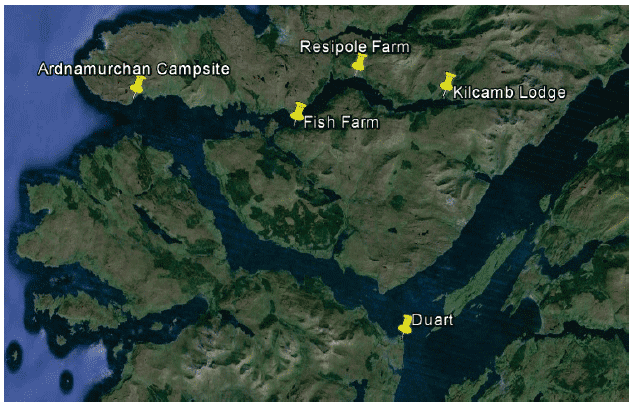
Table 7 Available wind data locations and start and end dates
| Location | Coordinates | Start date | End date | Elevation |
|---|---|---|---|---|
| Kilcamb Lodge | 56.691, -5.576 | 13/03/2013 16:00 | 16/07/2013 10:00 | 8m |
| Fish Farm | 56.662, -5.844 | 12/03/2013 12:00 | 16/07/2013 12:00 | 7m |
| Resipole Farm | 56.711, -5.734 | 13/03/2013 11:00 | 16/07/2013 10:00 | 6m |
| Ardnamurchan Campsite | 56.689, -6.132 | 12/03/2013 17:00 | 15/07/2013 10:00 | 8m |
| Castle Duart | 56.453, -5.651 | 11/03/2013 18:00 | 05/11/2013 08:00 | 41m |
13. Wind Roses
Wind roses were plotted at the five locations shown in Figure 18 for the overlapping period between 13/03/2013 16:00 and 15/07/2013 10:00. These wind roses are presented in Figure 19. Initially it was thought that Ardnamurchan campsite could be used as the reference location as it is at the seaward end of Loch Sunart. However on inspection of the wind roses it was clear that this would not be appropriate as the Ardnamurchan campsite is subject to topographic channeling of wind. The prevailing wind direction in the UK is the southwest, at Ardnamurchan the dominant wind directions are northwest and southeast, with the strongest wind coming from the southeast. This suggests there is some channeling of the wind through the Sound of Mull. Ideally a reference location in the open sea close to the entrance of Loch Sunart would be used, unfortunately such data is not available. The best available data for the reference location has been identified as Duart. Comparison of the 2012 Met Office data with the measured data at Duart shown in Figure 11 and 12 show that the wind at Duart is relatively unaffected by the topographic influences, this is likely to be due to the elevation of the weather station (41m above sea level) and its relatively exposed location. The wind roses at the other locations within Loch Sunart do show evidence of topographic funnelling of wind. It is most obvious at Resipole Farm and Kilcamb Lodge.
Figure 19 Wind roses at a) Ardnamurchan Campsite, b) Fish Farm, c) Resipole Farm, d) Kilcamb Lodge and e) Duart
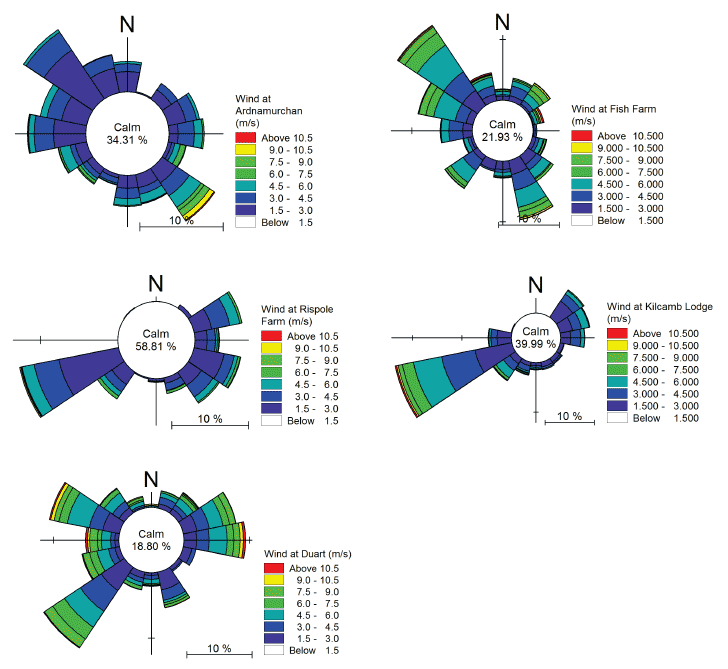
14. Correlation Plots
The wind speed ratios and wind direction differences for the 16 directional sectors at each of the stations in Loch Sunart to Duart were calculated using the methods outline in Part 1. The results are shown in Figure 20 to 23 and in Table 8.
Figure 20 Wind speed ratios and direction differences between Ardnamurchan Campsite and Castle Duart. Red Squares represent the number of points used to determine the correlation ratio
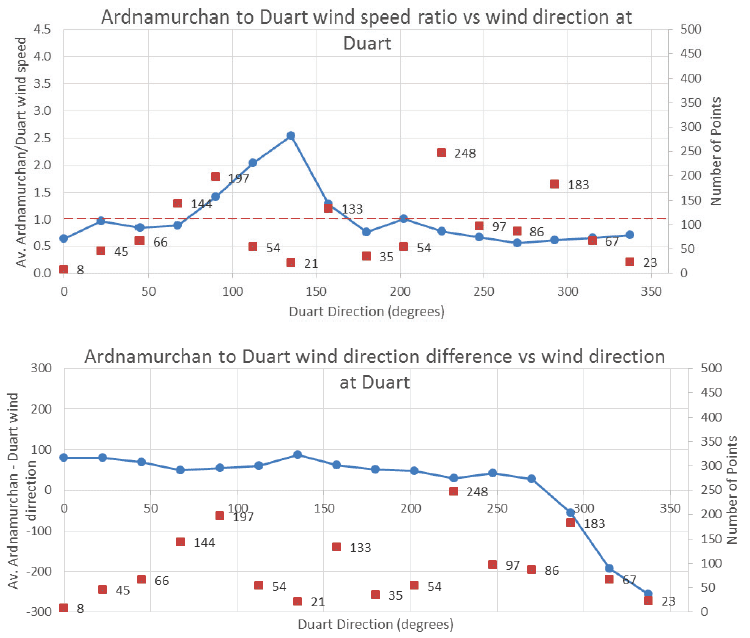
At Ardnamurchan campsite the wind speed is lower than that at Castle Duart between 180° and 67.5° degrees, with a ratio of between 0.64 and 1. The wind speed is higher at Ardnamurchan for winds from 90° to 157.5° with a peak at 135° ( SE).
Figure 21 Wind speed ratios and direction differences between the Fish Farm and Castle Duart. Red Squares represent the number of points used to determine the correlation ratio
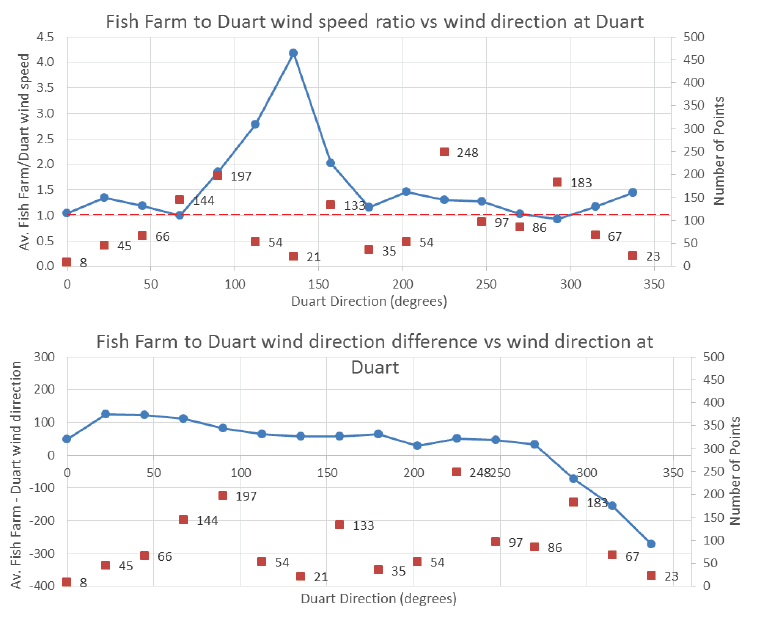
At the Fish Farm location wind speeds are generally higher than at Duart, with the ratio of wind speed only dropping below 1 for two directions (67.5° - ENE and 292.5° WNW). For the majority of directions the wind speed ration is between 1 and 1.5 (180° - 67.5°). As seen at Ardnamurchan there is a peak in the wind speed ratio around wind from the SE, this time the winds are over four times greater at the Fish Farm than Duart.
Figure 22 Wind speed ratios and direction differences between Resipole Farm and Castle Duart. Red Squares represent the number of points used to determine the correlation ratio
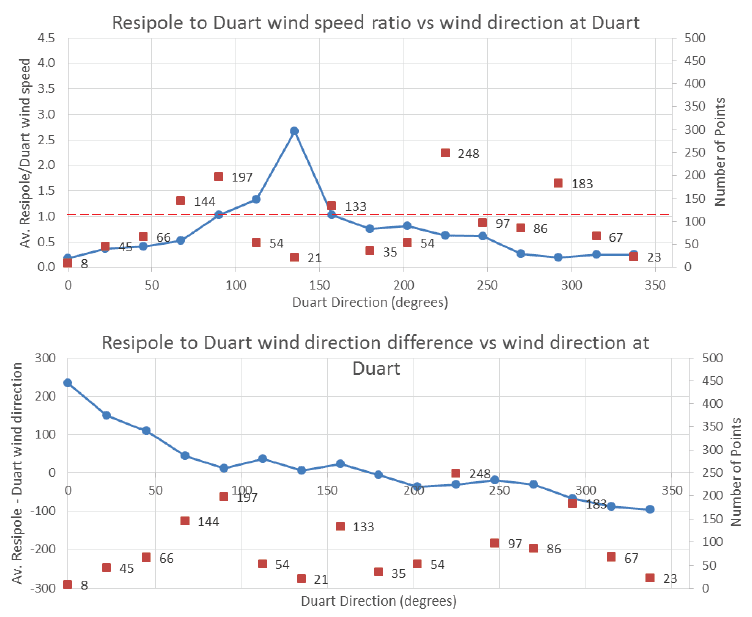
The wind speed ratios for Resipole Farm are the lowest of all the stations, ranging from 0.17 to 0.81 between 202.5° and 67.5°. The peak in the wind speed ratio for winds from the SE is still seen.
Figure 23 Wind speed ratios and direction differences between Kilcamb Lodge and Castle Duart. Red Squares represent the number of points used to determine the correlation ratio
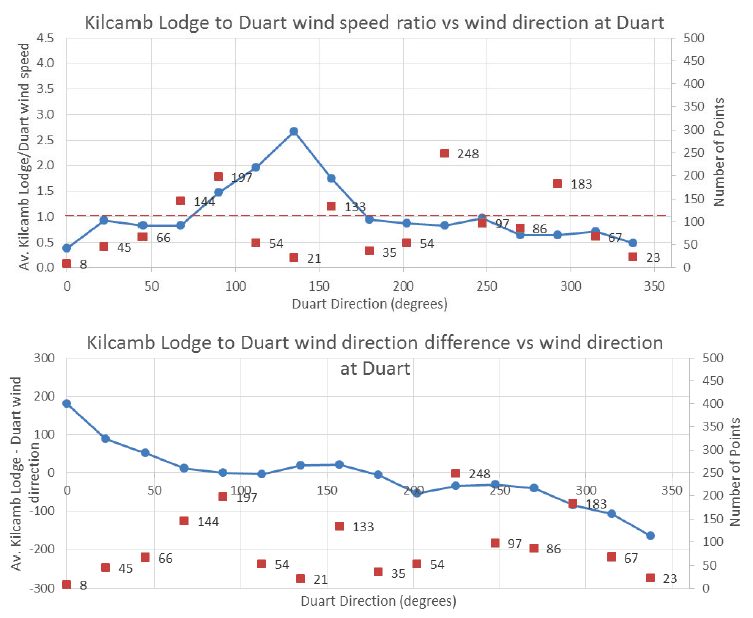
The wind speed ratios between Kilcamb Lodge and Castle Duart are between 0.5 and 1 from 180° to 67.5°. Again the peak in the wind speed ratio for winds from the SE is seen. It is worth noting that these peaks in ratio seen at all the locations within Loch Sunart is based on only 21 samples at 135°, 54 samples at 117.5°. The results in the correlation plots are summarised in Table 9.
Table 8 Wind speed ratios and direction differences for the weather stations in Loch Sunart with wind at Duart
| Directional sectors |
Av. wind speed ratio Ardnamurchan/Duart |
Av. wind direction difference Ardnamurchan - Duart |
Av. wind speed ratio Fish Farm/Duart |
Av. wind direction difference Fish Farm - Duart |
Av. wind speed ratio Resipole/Duart |
Av. wind direction difference Resipole - Duart |
Av. wind speed ratio Kilcamb/Duart |
Av. wind direction difference Kilcamb - Duart |
|
|---|---|---|---|---|---|---|---|---|---|
| N | 348.75-11.25 | 0.64 | 80.2 | 1.04 | 47.8 | 0.17 | 234.8 | 0.38 | 180.0 |
| NNE | 11.25-33.75 | 0.96 | 79.0 | 1.35 | 125.5 | 0.37 | 149.5 | 0.92 | 88.5 |
| NE | 33.75-56.25 | 0.84 | 69.5 | 1.19 | 122.4 | 0.41 | 109.4 | 0.83 | 52.5 |
| ENE | 56.25-78.75 | 0.88 | 48.8 | 0.99 | 110.3 | 0.52 | 43.4 | 0.83 | 10.8 |
| E | 78.75-101.25 | 1.42 | 54.4 | 1.85 | 82.0 | 1.03 | 11.7 | 1.47 | -0.1 |
| ESE | 101.25-123.75 | 2.04 | 59.2 | 2.79 | 65.0 | 1.32 | 36.3 | 1.96 | -4.2 |
| SE | 123.75-146.25 | 2.54 | 86.8 | 4.18 | 56.8 | 2.67 | 5.9 | 2.67 | 18.2 |
| SSE | 146.25-168.75 | 1.28 | 61.4 | 2.01 | 58.2 | 1.03 | 23.8 | 1.75 | 21.0 |
| S | 168.75-191.25 | 0.77 | 51.8 | 1.15 | 64.3 | 0.75 | -6.8 | 0.95 | -6.4 |
| SSW | 191.25-213.75 | 1.00 | 47.9 | 1.46 | 28.3 | 0.81 | -37.3 | 0.86 | -53.3 |
| SW | 213.75-236.25 | 0.78 | 29.5 | 1.30 | 50.7 | 0.62 | -29.9 | 0.82 | -33.8 |
| WSW | 236.25-258.75 | 0.66 | 41.0 | 1.27 | 46.6 | 0.62 | -20.1 | 0.97 | -31.0 |
| W | 258.75-281.25 | 0.56 | 27.3 | 1.03 | 32.2 | 0.26 | -29.8 | 0.64 | -39.5 |
| WNW | 281.25-303.75 | 0.62 | -55.9 | 0.93 | -71.8 | 0.19 | -67.3 | 0.64 | -85.3 |
| NW | 303.75-326.25 | 0.66 | -193.6 | 1.17 | -155.8 | 0.25 | -89.0 | 0.71 | -107.1 |
| NNW | 326.25-348.75 | 0.71 | -255.8 | 1.45 | -272.0 | 0.25 | -95.4 | 0.48 | -165.3 |
Table 9 Variation in observed wind data at stations within Loch Sunart
| Direction Sector |
Ardnamurchan |
Fish Farm |
Resipole Farm |
Kilcamb Lodge |
|---|---|---|---|---|
| 180 - 67.5 oN |
Wind speed at Ardnamurchan is lower than at Duart. Minimum ratio of 0.56 for wind from 270 +/- 11.25 oN. |
Wind speed at the Fish Farm is slightly higher or the same as at Duart, between 0.93 and 1.45 |
Wind speed at Resipole Farm is lower than at Duart. Minimum ratio of 0.17 for wind from 0 +/- 11.25 oN. |
Wind speed at Kilcamb Lodge is lower than at Duart. Minimum ratio of 0.38 for wind from 0 +/- 11.25 oN. |
| 67.5 - 180°N |
Wind speed at Ardnamurchan is higher than at Duart. Maximum ratio of 2.54 for wind from 135 oN. |
Wind speed at Fish Farm is higher than at Duart. Maximum ratio of 4.18 for wind from 135 oN. |
Wind speed at Resipole Farm is higher than at Duart. Maximum ratio of 2.67 for wind from 135 oN. |
Wind speed at Kilcamb Lodge is higher than at Duart. Maximum ratio of 2.67 for wind from 135 oN. |
15. Recommendations
Although the results of this analysis have not been implemented in the wind corrections used in the model guidance on how they could be implemented is given here. The first step would be to determine a time series of wind speed and direction at each location within Loch Sunart based on a time series at Castle Duart and the wind speed ratios and direction differences presented above. Due to the potential for overlapping interpolation around Ardnamurchan campsite it is necessary to add an interim point. The time series at this point will be determined by linear interpolation from Duart to Ardnamurchan. Once these time series have been established the next step would be to interpolate between the points as shown in Figure 24, i.e. linearly from Castle Duart to the interim point, triangulation between Ardnamurchan Campsite, the Interim Point and the Fish Farm, linearly from the Fish Farm to Resipole Farm and finally linearly from Resipole Farm to Kilcamb Lodge. The solid black lines in Figure 24 indicate the lines along which the values from each location will be defined.
Figure 24 Recommended method for interpolation of corrected winds
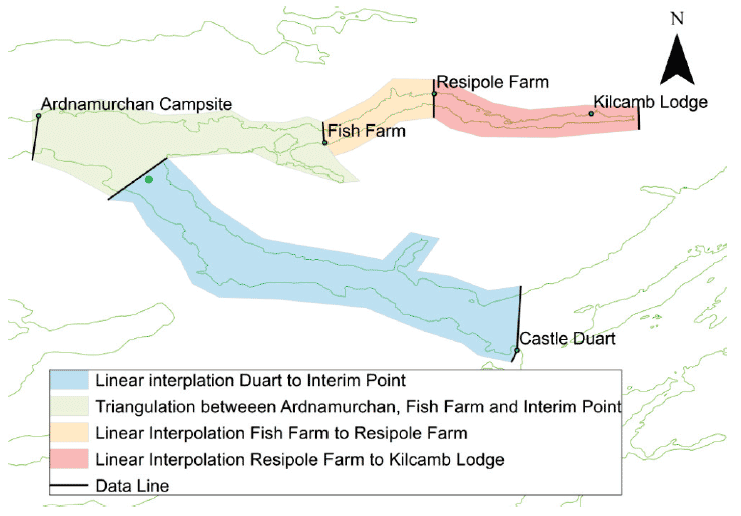
16. Limitation
The proposed methodology outlined above for wind interpolation in Loch Sunart has a number of limitations, not least the data available for the analysis. The length of the time series and the number and locations of the stations is not ideal. Four months is not sufficient to develop a robust relationship between the winds at these locations. It would be preferable if the location of the reference station (Duart) was closer to the mouth of Loch Sunart and in an exposed location, ideally in open water. Also the wind stations are located at points where the orientation of the Loch changes, ideally data would be available along the straight sections of the loch to better capture the effect of the wind channelling.
Appendix A: Correlation Plots
Reference Point: Duart Datasets: 1 and 2
Wind Speed (removed directions with less than 30 points)
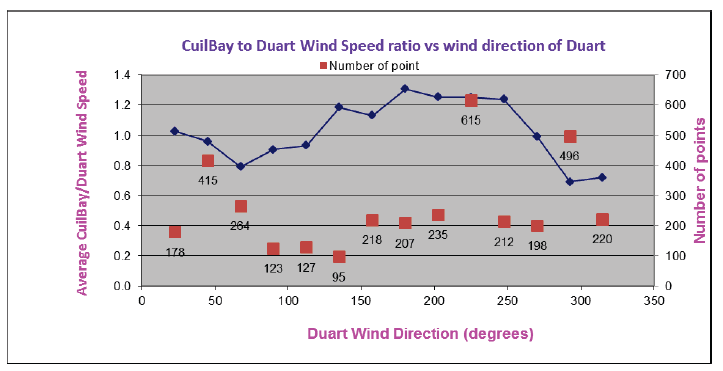
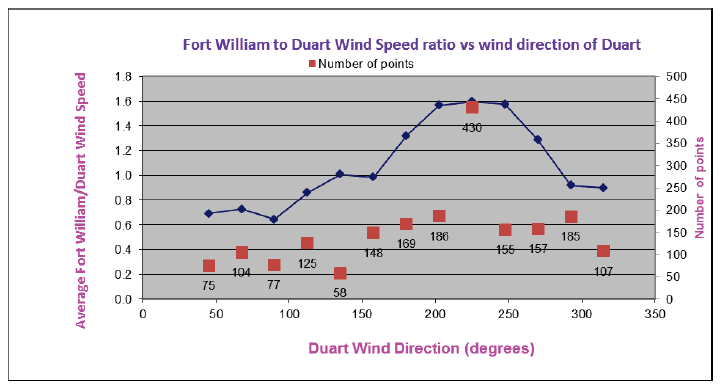
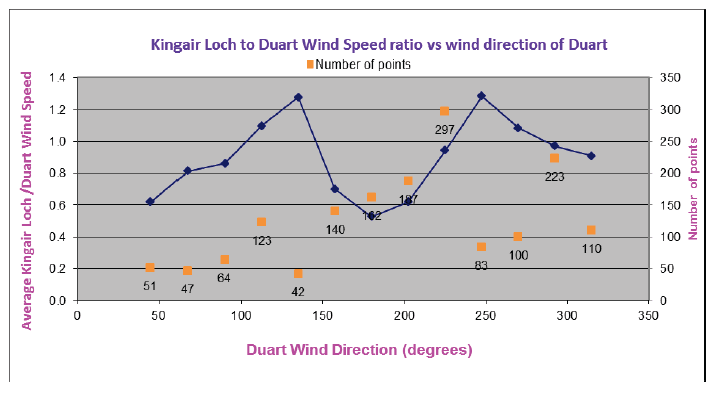
Wind Direction (removed directions with less than 30 points)
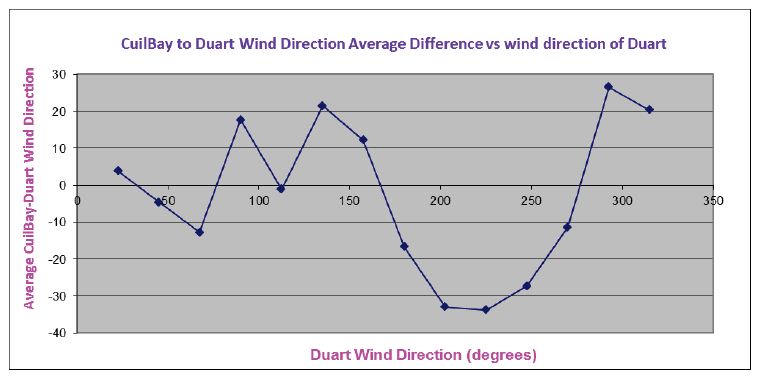
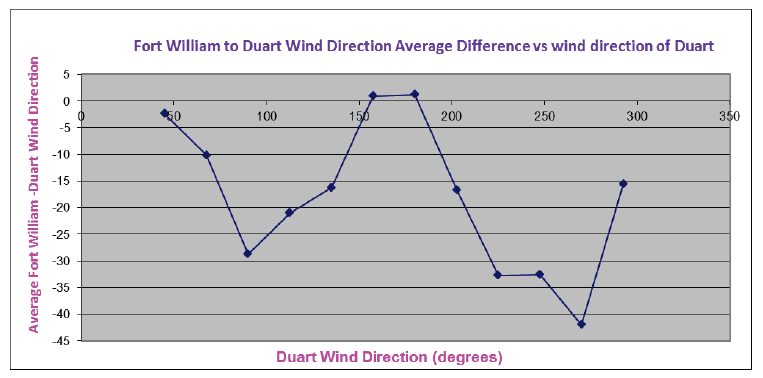
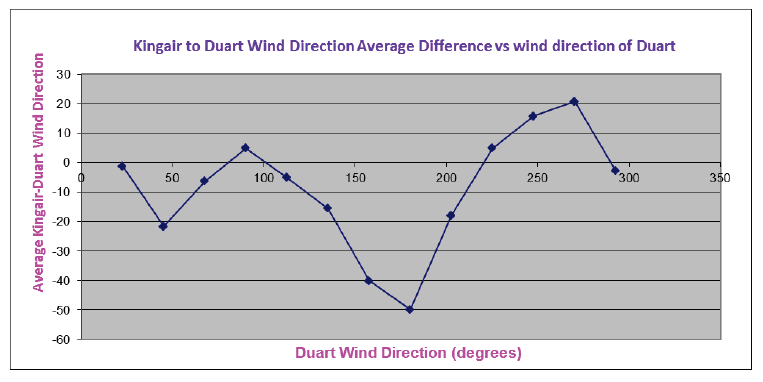
Appendix B: X-Y Plots
X-Y Plots Wind Speed (Datasets 1 and 2)
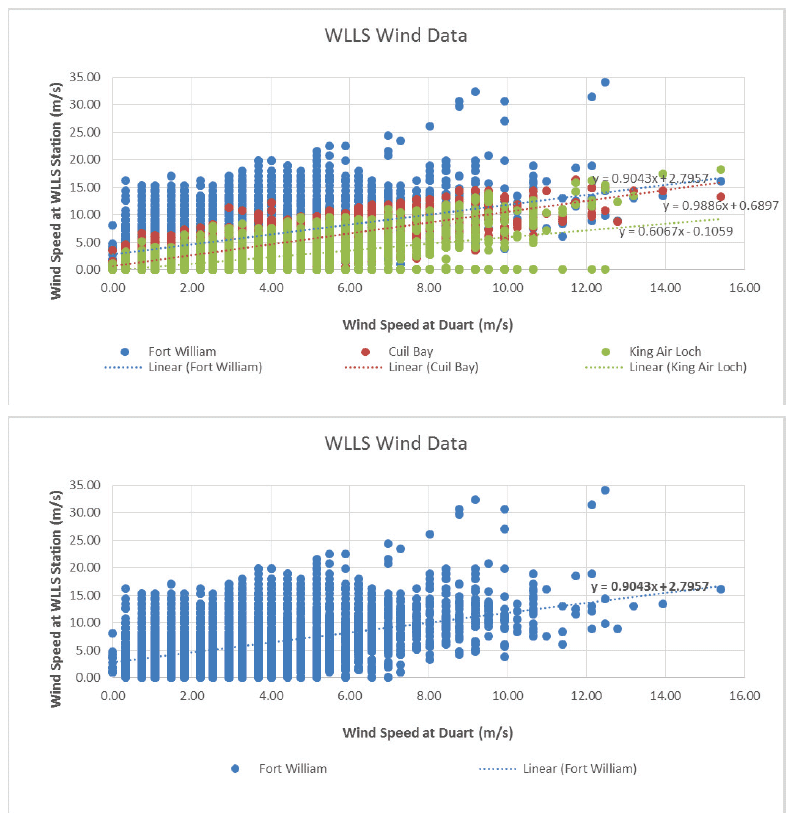
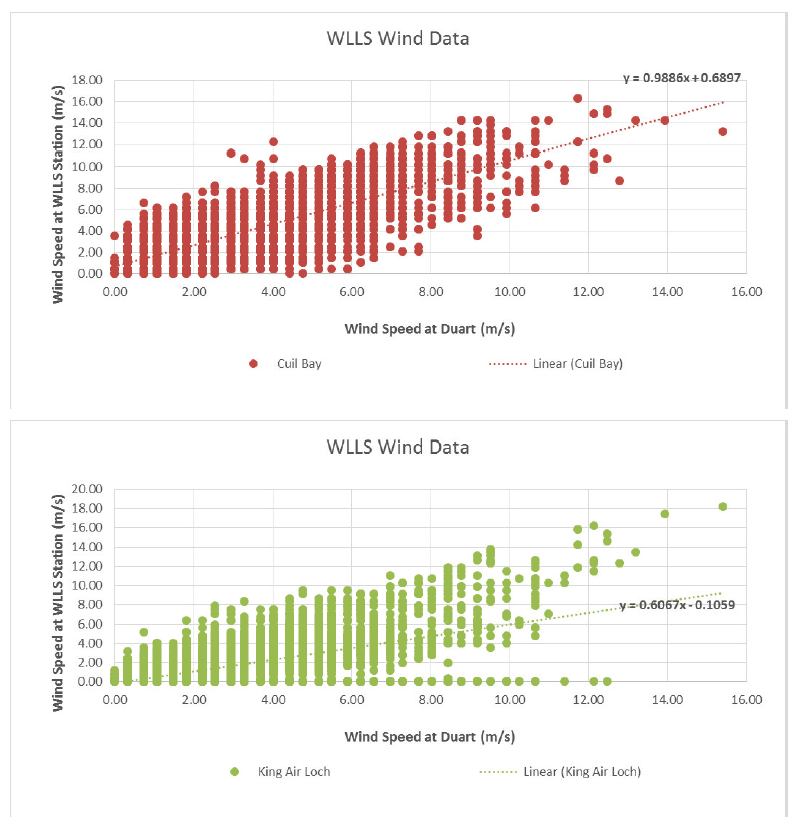
X-Y Plots Wind Direction (Datasets 1 and 2)
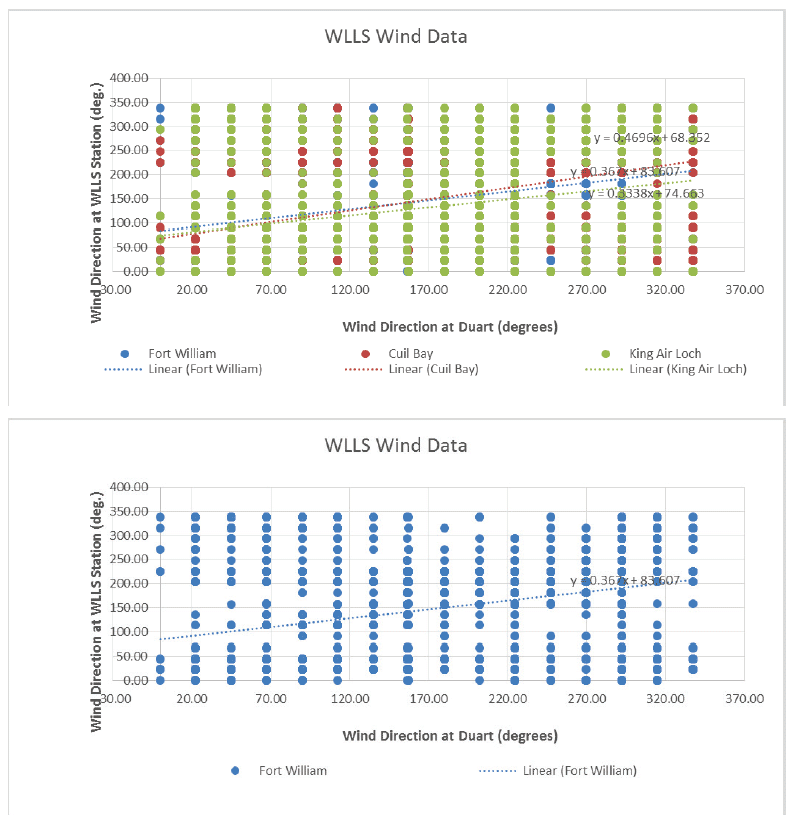
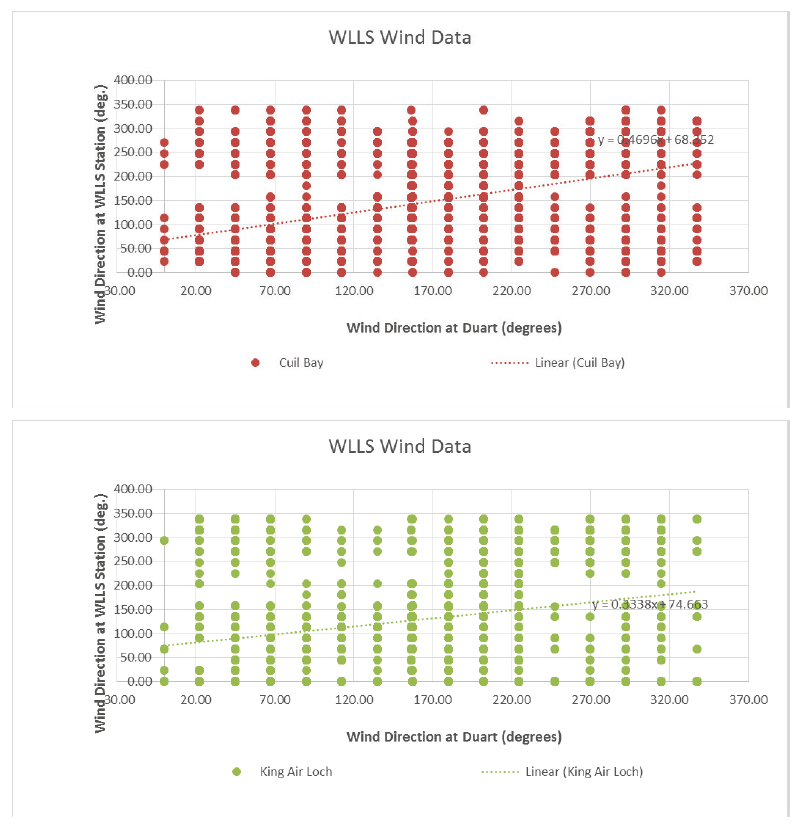
Contact
There is a problem
Thanks for your feedback